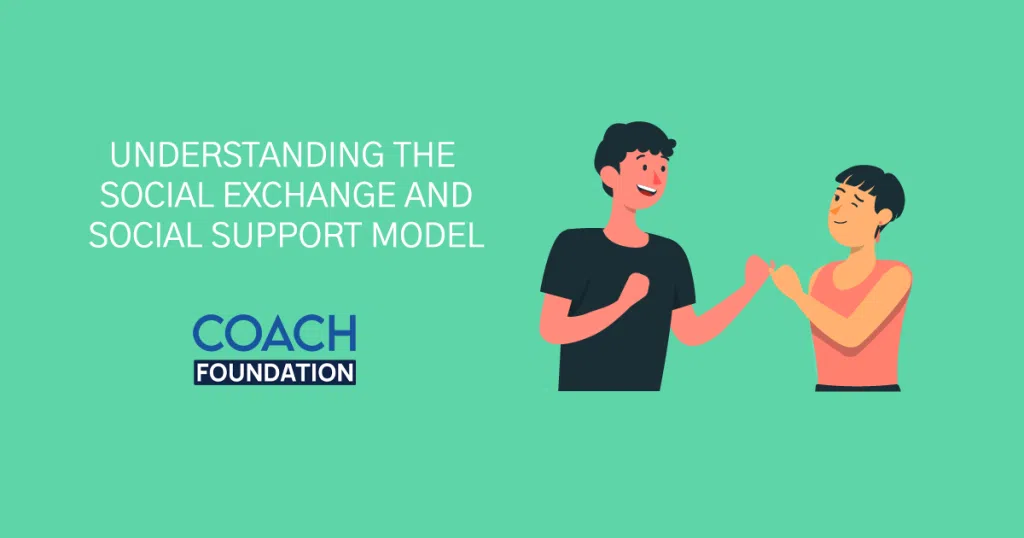Blog » Coaching Models and Techniques » The Social Exchange and Social Support model
The Social Exchange and Social Support model
The social exchange and social support model is a theoretical framework that explains how social support can be exchanged between individuals in social relationships. It implies that social support is a beneficial resource that people in need can receive from others and provide to them.

The model proposes that individuals engage in social exchanges to maintain and enhance their social relationships, and that social support is a key component of these exchanges. It also suggests that the quality and quantity of social support exchanged can impact individuals’ physical and mental health outcomes.
In this blog, we’ll explore:
1. Fundamentals of Social Exchange and Social Support Model
2. History of the model
3. Components of the Social Exchange and Social Support Model
4. Working of the Social Exchange and Social Support Model
5. Pros and Cons of Social Exchange and Social Support Model
So, let’s get started!
Fundamentals of Social Exchange and Social Support Model
The Social Exchange and Social Support model proposes that social support is a key component of social relationships and can impact individuals’ physical and mental health outcomes. Here are the fundamentals of the model:
- Social exchange: The model suggests that individuals engage in social exchanges to maintain and enhance their social relationships. These exchanges involve the exchange of resources, such as social support, between individuals.
- Social support: Social support is a valuable resource that can be provided by others and received by individuals in need. It can come in various forms, including emotional support, instrumental support, informational support, and appraisal support.
- Types of exchanges: The model identifies two types of exchanges – reciprocal exchanges and negotiated exchanges. Reciprocal exchanges involve the exchange of resources without explicit negotiation, while negotiated exchanges involve the explicit negotiation of resources.
- Quality and quantity of support: The model suggests that the quality and quantity of social support exchanged can impact individuals’ physical and mental health outcomes. Higher levels of social support can lead to better health outcomes.
- Cost and benefit analysis: The model proposes that individuals engage in a cost and benefit analysis when deciding whether to provide or receive social support.
- Trust and reciprocity: Trust and reciprocity are important factors in social exchanges and social support. Trust is essential for individuals to feel comfortable providing or receiving social support, while reciprocity encourages individuals to continue providing support.
- Social network: The model suggests that individuals’ social networks play a crucial role in determining their access to social support.
- Cultural context: The model acknowledges that cultural factors can influence social support exchanges and that different cultural groups may have different norms and expectations regarding social support.
Check out this intriguing video about social exchange theory!
History of the Model
The social exchange and social support model has its roots in social exchange theory, which emerged in the 1960s as a way of understanding how individuals engage in social interactions to maximize their rewards and minimize their costs. Researchers who were examining the function of social support in promoting well-being further developed the model in the 1970s and 1980s.
One of the earliest and most influential researchers in this area was George Homans, who proposed that social exchanges involve a system of rewards and costs that individuals weigh when deciding whether to engage in social interactions. Another key figure in the development of the social exchange perspective was Peter Blau, who argued that social exchange is a fundamental aspect of all social relationships.
In the 1980s, researchers began to focus more specifically on the role of social support in social exchanges. For example, researchers like Irwin G. Sarason and Sheldon Cohen studied how social support can buffer the negative effects of stress on health outcomes. Today, the social exchange and social support model continues to be an important theoretical framework for understanding the role of social support in promoting health and well-being.
Impact of Social Exchange on Relationships
Social exchange theory suggests that individuals engage in social interactions to maximize rewards and minimize costs.
This can impact relationships by affecting the balance of rewards and costs exchanged between individuals and ultimately influencing the stability and satisfaction of the relationship. Below are the major impacts of social exchange on relationships:
1. The Honeymoon Phase
Intense feelings of passion, love, and excitement during the early stages of a relationship are a common phenomenon in romantic relationships known as the honeymoon phase. Social exchange theory suggests that during this phase, individuals are highly motivated to engage in social exchanges that maximize rewards and minimize costs.
As a result, they may engage in behaviors that are highly rewarding for their partner, such as showing affection, being attentive, and expressing love. However, as the relationship progresses, the balance of rewards and costs may shift, and individuals may become less motivated to engage in these behaviors. This can lead to a decline in relationship satisfaction and stability as the initial rewards of the honeymoon phase diminish.
2. Evaluating the Alternatives
Evaluating alternatives is an important aspect of social exchange theory that can impact relationships. This involves weighing the rewards and costs of different alternatives to the current relationship. If an individual perceives that the alternatives offer greater rewards and fewer costs than the current relationship, they may be more likely to consider ending the relationship.
This can lead to a decline in relationship satisfaction and stability. Conversely, if the individual perceives that the rewards of the current relationship outweigh the costs and are greater than the rewards offered by the alternatives, they are more likely to remain committed to the relationship.
3. Equity Determines Health
Equity, or the perception of fairness in social exchanges, is a critical factor in determining the health of a relationship. Social exchange theory suggests that individuals strive to achieve a balance of rewards and costs in their relationships. When there is a perceived imbalance, such as when one partner feels they are putting in more effort than the other, this can lead to feelings of resentment and dissatisfaction.
Over time, this can negatively impact the health of the relationship, including both physical and mental health outcomes. Conversely, when there is a sense of equity in the relationship, both partners feel valued and satisfied, leading to better overall health and well-being.
I went through this intriguing article explaining the impact of social exchange on relationships, and I would suggest the readers go through it once!
How does the Social Exchange and Social Support model work
The social exchange and social support model proposes that social support can act as a form of exchange in relationships where individuals provide support to others in exchange for emotional or tangible rewards. The model works by considering the costs and rewards of providing support as well as the impact of these exchanges on the overall health and well-being of the individuals involved.
For example, if a person provides emotional support to a friend who is going through a difficult time, they may receive gratitude, feelings of accomplishment, and a strengthened sense of social connectedness as rewards. However, the costs of providing this support may include time, effort, and emotional energy expended in the process. If the balance of costs and rewards is favorable, this exchange can contribute positively to the overall health and well-being of both individuals.
On the other hand, if the costs of providing support outweigh the rewards or if the support is not reciprocated, this can lead to feelings of resentment, dissatisfaction, and strain in the relationship. This can negatively impact the health and well-being of the individuals involved, potentially leading to negative health outcomes such as increased stress and decreased immune functioning.
Pros and Cons of Social Exchange and Social Support Model
Like any theory, the social exchange and social support model has its own set of strengths and weaknesses. Understanding the potential benefits and limitations of the model can help researchers and practitioners use it effectively.
Pros:
- Provides a theoretical framework for understanding how social support can impact health and well-being.
- Emphasizes the importance of considering both costs and rewards in social interactions.
- Can inform interventions aimed at improving social support and well-being.
- Highlights the role of reciprocity in maintaining healthy relationships.
- Helps to explain the role of social support in buffering the negative effects of stress on health outcomes.
Cons:
- The model is criticized for oversimplifying complex social interactions.
- Does not account for the role of cultural differences in social exchanges.
- The model does not address the impact of power dynamics and inequalities in social exchanges.
- Can be difficult to measure and quantify social support and its impact on health outcomes.
- The model may not account for the complexity of human emotions and motivations in social interactions.
Conclusion
Social Exchange Theory provides a useful framework for understanding the dynamics of social interactions and relationships. By focusing on the cost-benefit analysis involved in social interactions, the theory highlights the importance of equity and reciprocity in maintaining positive relationships.
Social Exchange Theory has been applied to a wide range of fields, including psychology, sociology, and economics, and has helped shed light on important phenomena such as trust, commitment, and cooperation. Overall, the theory provides valuable insights into the nature of human social interactions and relationships.
Your feedback and input are valuable in promoting a deeper understanding of the topic and facilitating a more enriching discussion. I look forward to hearing your thoughts in the comment section.
Frequently Asked Questions (FAQs)
What is the concept of social exchange theory?
Social Exchange Theory is a social psychological theory that explains how people evaluate their relationships and interactions based on the costs and benefits involved. It suggests that individuals seek to maximize rewards and minimize costs in social interactions and that equity and reciprocity are important in maintaining positive relationships.
What are a few examples of social exchange theory?
Some examples of social exchange theory include:
1. An individual decides to maintain a friendship because the benefits of social support outweigh the costs of investing time and effort into the relationship.
2. A romantic couple who strive for equitable division of household chores to ensure that both partners feel that they are contributing fairly.
3. An employee who decides to remain in a job despite a low salary because the benefits, such as job security and opportunities for advancement, outweigh the costs.
Who founded social exchange theory?
George Homans and Peter Blau, two social psychologists, first created Social Exchange Theory in the early 1960s. Homans, in particular, is often credited as the founder of the theory, as he was one of the first to articulate the idea that social behavior is shaped by a cost-benefit analysis. Over time, other social scientists have built on and refined the theory, leading to its continued relevance and influence today.

ABOUT SAI BLACKBYRN
I’m Sai Blackbyrn, better known as “The Coach’s Mentor.” I help Coaches like you establish their business online. My system is simple: close more clients at higher fees. You can take advantage of technology, and use it as a catalyst to grow your coaching business in a matter of weeks; not months, not years. It’s easier than you think.
AS SEEN ON





